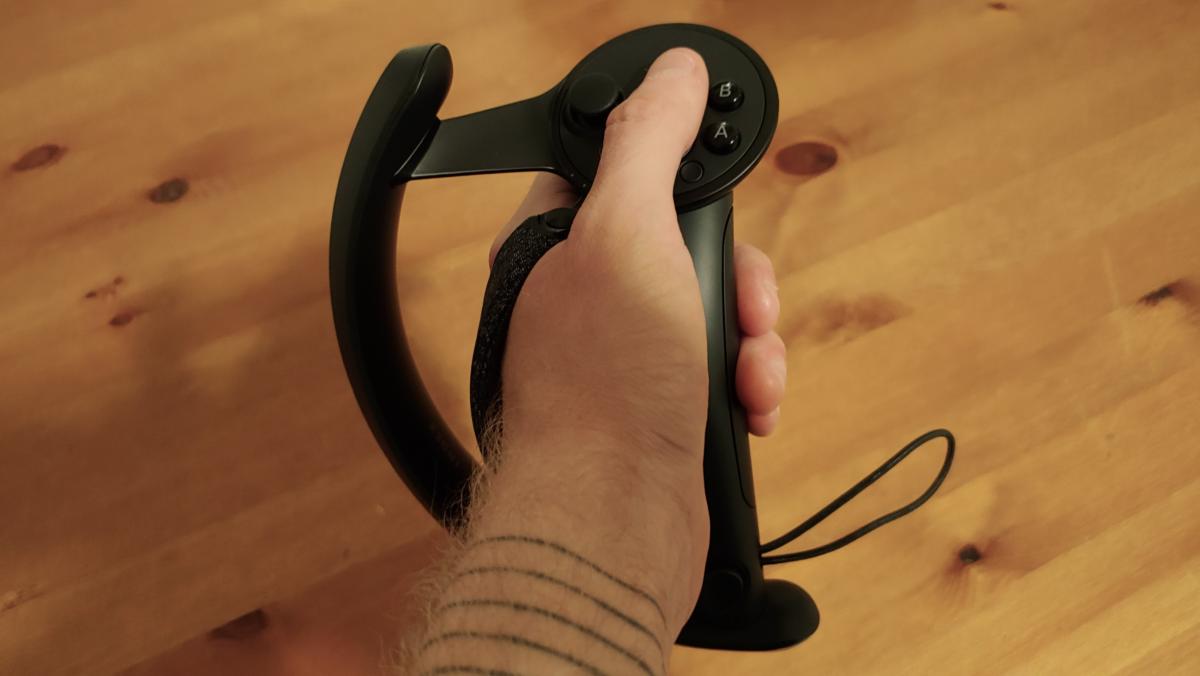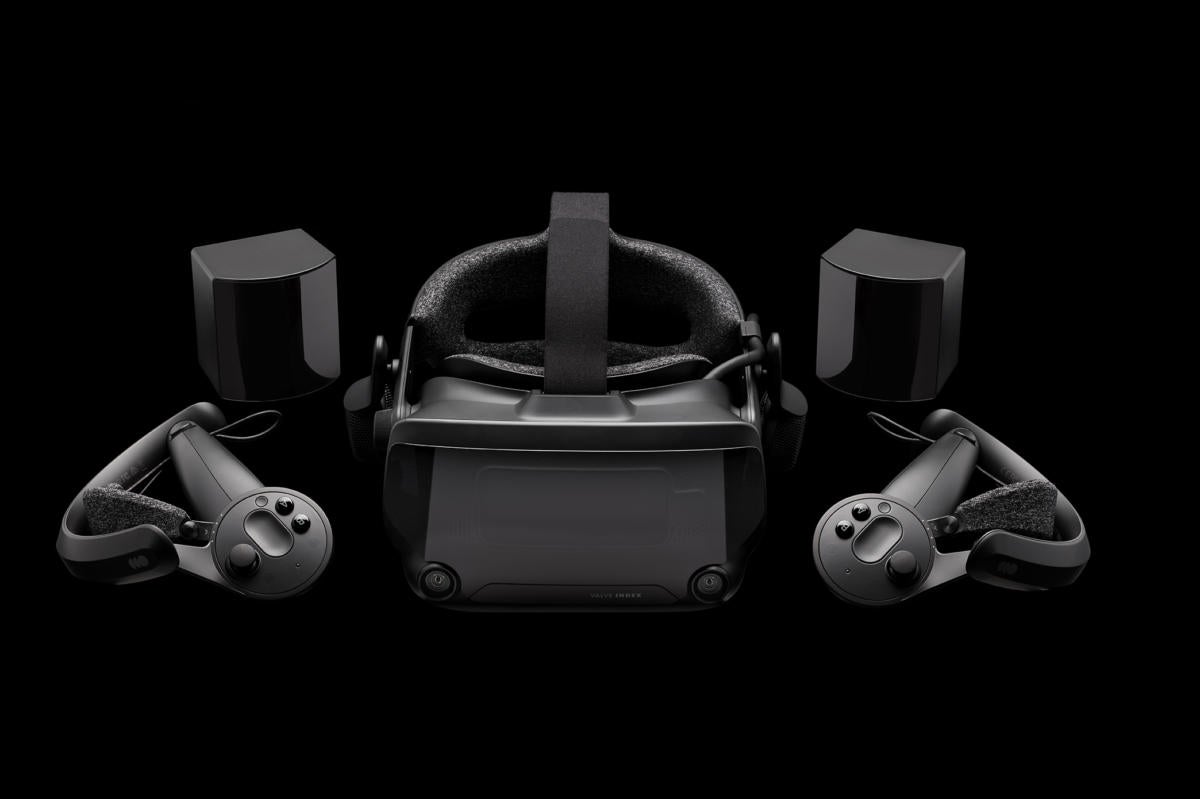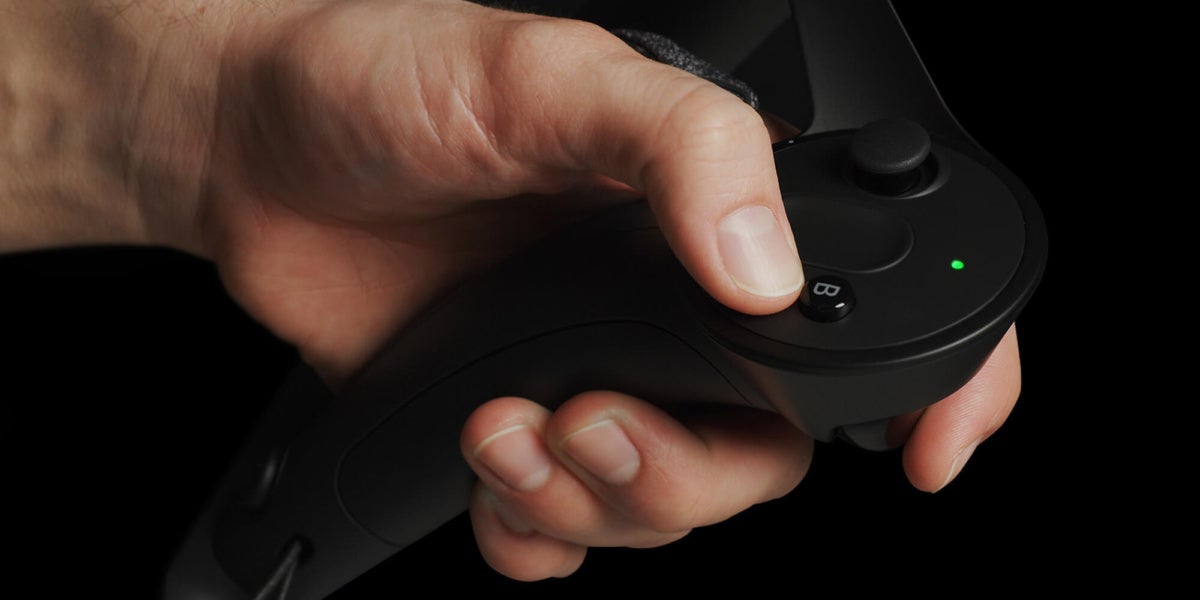 At a Glance
At a GlanceExpert's Rating
Pros
- Adds a lot more capability to VR controls
- Lots of potential for social interactions in VR
- Analog sticks are more useful than the Vive’s touchpads
Cons
- Expensive
- Limited software selection at release
- Takes a lot of practice to grow accustomed
Our Verdict
Valve’s Index Controllers have the potential to be a huge leap forward for motion-tracked controls and virtual reality, but it’ll take patience—and a lot more developer support—before they’re a must-have.
Best Prices Today: Valve Index Controllers
Last month we put out some initial impressions of Valve’s new Index virtual reality headset. I’ve now used it off-and-on in my home for about a month, and the first units are going out to consumers, which means it’s time for a proper review.
It’s a bit odd though, reviewing the Index. Valve’s hands-off approach to its hardware, its lead-and-the-developers-will-follow mindset, means the Index’s first few steps into the limelight are more tepid than I would’ve liked. The hardware is great. The software support so far? Less so.
The knock-on effect is that at release, the Index headset feels like a great investment, an incremental but significant step forward for those who want the best fidelity money can buy. The so-called “Knuckles” Index Controllers are supposed to be the draw though, and are undercut by the fact few games support them. They may become must-have peripherals eventually, but you’re going to have to take on faith that developers will do the work.
This review’s long, and the Index Controllers can also be used with HTC Vive headsets, so I’ve split it in two parts. Keep reading for my impressions on the Index Controllers, or click here to read about the Valve Index headset itself.
Hands-off hands-on
Here’s the thing: The Index HMD is great, but will likely be supplanted by a newer and better headset in a year or two at most. The Index Controllers are a bolder bet, forward-thinking and future-proofed peripherals that if successful could change the way people interact with VR.
“If successful” is a huge caveat though, and the obstacles are myriad.
 IDG / Hayden Dingman
IDG / Hayden DingmanThe first obstacle is personal. Adjusting to the Index Controllers takes time. It takes patience. And I think that applies even more to people who already own a VR headset and have grown accustomed to the status quo. The Vive wands and Oculus Touch controllers essentially work the same way: You hold onto them. Button placement varies, and the Oculus Touch better emulates the shape and function of the user’s hand compared to the Vive’s crude cylinders. But in both cases, you’re grasping an object at all times.
The Index Controllers are different. They’re meant to enable “Picking Up” and “Dropping” digital objects, the way you would in real life. You put your hands through the Index Controllers, then tighten straps across the back of your hands to keep them in place. Thus the idle position for Index is not “Holding A Tool” but rather palm open, hand empty.
Even a month in, I find myself struggling at times. Here’s an experiment: Take a finger on one hand and push it into the palm of the other. Notice how your hand wants to collapse inward, as if to grab whatever is pressing into it?
With conscious thought I can force myself to keep my hands open, but my inclination is to hold onto the Index Controller, and I’ve struggled wrapping my head around “Dropping” items in particular. “Wait, I’m supposed to just open my hand and let go of this object that has weight and substance in the real world?” On paper it sounds like it should be more intuitive—removing a layer of abstraction and doing with your hand what you’d previously do with a button—but in practice I’d say the opposite is true. I still find myself fighting my instincts on a semi-regular basis.
Finger tracking is more successful, albeit with less effect on how you interact with virtual worlds. The Index Controllers are laden with sensors, allowing them to track individual fingers and reproduce those motions digitally. And yes, the first thing everyone will try is giving the ol’ middle finger to enemies. It works.
 IDG / Hayden Dingman
IDG / Hayden Dingman
Or this more family-friendly gesture
Does it really matter? Maybe for social applications. Oculus Touch and its capacitive buttons allow for some basic gestures, like a thumbs up or finger guns. But with the Index Controllers, anything you can do with your hands in real life (short of splaying or intertwining your fingers) can probably be done in VR. Valve and Cloudhead’s free Aperture Hand Lab is an entertaining tutorial, giving you a good rundown of the Index Controller’s capabilities in a creative way.
That said, most object interactions are covered by Oculus Touch when you break it down. Touch allows you to simulate an open hand, a pointed index finger, or a fist. That…pretty much covers what you need. Once the novelty of counting to three wears off, you kind-of realize finger tracking won’t have a huge impact on how you interact with digital environments, certainly not on the same level as the Index’s open-hand drop/grasp capabilities. It feels like a neat gimmick, and one I quickly stopped noticing—which, on some level, means it’s working. My hands acted like hands! But I don’t think it’s a selling point unless developers get creative.
Fall in line (or don’t)
Which brings us to the second obstacle, the Index Controllers’ main caveat: There’s nothing to do with them.
Okay, “Nothing” is admittedly a bit harsh. Valve notoriously takes a hands-off (heh) approach to its hardware though. It isn’t forcing developers to add Index Controller support. Hell, as far as I know Valve isn’t even incentivizing developers to add support, isn’t funding that development the way Oculus might. Valve’s mantra is effectively “If we build it, they will come.”
 Valve
ValveThat works fine for hardware like the Index headset, where games benefit from wider FOV and a higher resolution without any developer support. But the controllers?
Support is spotty. On Thursday we obtained the full Valve Index “launch list,” of sorts. All the hits are there, Beat Saber and Arizona Sunshine and Vacation Simulator and Superhot VR. Aside from the aforementioned Aperture Hand Labs though, there’s no standout title on release day that you can point to and say “This is why you need Index Controllers.” Sure, a lot of people’s favorite VR experiences are here, but adding Index Controller support to Arizona Sunshine or Superhot VR doesn’t fundamentally transform those games. It just means there’s a different way to pick up guns now.
Even with games that ostensibly support Index Controllers, I’ve seen wildly different implementations. For instance, Superhot VR does full finger tracking. You can hold up double-V peace signs to every enemy in that game if you’d like. Same with Vacation Simulator, though it’s more peaceful.
But Hot Dogs, Horseshoes & Hand Grenades doesn’t give you hands. It only added support for gripping objects. And Tilt Brush is on the list as well, but seems to have mostly taken advantage of the Index Controllers’ new analog sticks and redistributed buttons—an improvement over the Vive wands for sure, as it’s much easier to swipe between tool palettes and undo errors. There’s no finger tracking though, and you’re not picking up or dropping anything. It feels like Google basically duplicated what you could do with the Oculus Touch controllers, with nothing particularly Index-specific to speak of.
As for Beat Saber, I couldn’t even tell you what makes it “Index Compatible.” It runs on Index the same way it ran on the Vive wands, your hands permanently soldered to a pair of lightsabers. Seemingly nothing’s changed.
 Valve
ValveAs a result, the Index Controllers feel full of untapped potential. At the moment we’re mostly seeing haphazard integration with old games you’ve probably already played (if you’re a VR enthusiast at least). Hell, as I write this there’s not even a way to sort by Index Controller compatibility on Steam. You can only narrow by “Tracked Motion Controllers,” which includes Vive wands and Oculus Touch.
Maybe there will be some neat experiments down the line, but VR’s such a niche market it’s hard for developers to limit their games to a subset of a subset. Left to their own devices they usually target the lowest common denominator, and with Valve reticent to step in and fund third-parties to create Index-specific content it’s hard to know whether we’ll see anything that truly takes advantage—at least until Oculus has parallel functionality.
So that’s the final, slightly disappointing, takeaway. The Index Controllers should be the exciting part of the larger Index package, but so far the software selection leaves a lot to be desired, especially when it comes to existing VR adopters looking to add a new peripheral. If you’re new to VR? You’ll have a blast playing Beat Saber, Arizona Sunshine, Vacation Simulator, and so on for the first time—with finger tracking! But I’ve already played those games, some more than others, and adding Index support hasn’t changed them enough to draw me back in for more than quick demos.
Bottom line
I’m certainly curious what happens in the future, as the tech is solid—thus, the score. But if you asked me whether you should buy Index Controllers right now? In June of 2019? I’d struggle to give you a good reason, especially if it’s meant to replace existing hardware. The Vive wands are nothing special, but you’re not missing out on much by sticking with them for the moment and saving $279.
There’s even less reason to buy Valve’s 2.0 base stations if you already have a Vive. I feel like I covered that topic at length—along with the drawbacks of a tethered system—in our initial hands-on, so check there if you want more info. Valve’s original Lighthouse stations are more than enough for most home-scale setups though.
Which leaves the Index headset. I recommend reading our full review, but in short: It’s the most enticing part of the package at the moment, an immediate upgrade to any first-gen hardware and even a notable improvement over the Vive Pro. Of course, HTC’s Vive Cosmos is already on the horizon—due to switch to RGB LCD displays, add eye-tracking, and ditch base stations before the end of the year—so Valve’s reign could be short-lived, provided HTC’s made some FOV improvements as well.
We’ll see. Regardless, it’s clear that manufacturer interest in VR hasn’t dwindled one bit, as 2019’s already the most eventful year since the first consumer models released in 2016. Pull up a chair and watch the arms race.
